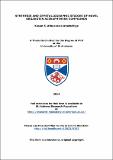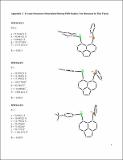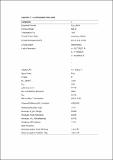Files in this item
Synthesis and crystallographic studies of novel organotin acenaphthene compounds
Item metadata
| dc.contributor.advisor | Slawin, Alexandra M. Z. | |
| dc.contributor.author | Athukorala Arachchige, Kasun Sankalpa | |
| dc.coverage.spatial | [15], 192 | en_US |
| dc.date.accessioned | 2015-03-26T15:51:27Z | |
| dc.date.available | 2015-03-26T15:51:27Z | |
| dc.date.issued | 2014-06-25 | |
| dc.identifier | uk.bl.ethos.640800 | |
| dc.identifier.uri | https://hdl.handle.net/10023/6363 | |
| dc.description.abstract | Organic frameworks with rigid backbones, such as acenaphthene, are highly suitable for the study of interatomic interactions. The short “natural” peri-distance (2.44 Å) and the rigidity of the aromatic system causes considerable steric strain between peri-substituted heteroatoms. As a consequence, substitution at both peri-positions leads to in- and out-of-plane distortions, which often result in buckling of the ring system. In order to relax this geometric strain, weak bonding interactions can also exist between the peri-substituents. This thesis focuses on the synthesis, structural characterisation and investigation of a range of sterically crowded peri-substituted acenaphthene compounds. This involves the study of the acenaphthene geometry, through X-ray crystallography when different peri-substituents occupy the close 5,6-positions; our main focus is to study weak non-bonded interactions that can occur across the peri-gap, for example weakly attractive three-centre four-electron (3c-4e) type interactions which are known to prevail in such compounds under the appropriate conditions. Repulsion within these systems, resulting from the steric crowding of the peri-space is also investigated, employing changes in bond lengths, bay-region angle splay, displacement of atoms from the mean plane and central acenaphthene torsion angles to help quantify the degree of acenaphthene distortion, which are all conveniently probed by the peri-distance. To this end we have synthesised a range of novel sterically crowded mixed bromo-tin acenaphthene derivatives (Chapter 3), chalcogen-tin acenaphthene molecules (Chapter 4), phosphorus–tin derivatives (Chapter 5) and a series of homologous tin-tin acenaphthenes (Chapter 6). All the compounds studied in this thesis were characterised by multinuclear NMR spectroscopy and X-ray crystallography in an effort to gain a greater understanding of the deformation that occurs when disparate functionalities are located in close proximity and explore the potential for weak non-covalent intramolecular interactions to occur. | en_US |
| dc.language.iso | en | en_US |
| dc.publisher | University of St Andrews | |
| dc.subject | Acenaphthene | en_US |
| dc.subject | X-ray crystallography | en_US |
| dc.subject | Peri-substitution | en_US |
| dc.subject | Donor-acceptor | en_US |
| dc.subject | Intramolecular | en_US |
| dc.subject | Tin | en_US |
| dc.subject | Phosphorus | en_US |
| dc.subject | Chalcogen | en_US |
| dc.subject | Bromine | en_US |
| dc.subject | Three centre-four electron | en_US |
| dc.subject.lcc | QD341.H9A8 | |
| dc.subject.lcsh | Polycyclic aromatic hydrocarbons--Synthesis | en_US |
| dc.subject.lcsh | Organotin compounds | en_US |
| dc.subject.lcsh | X-ray crystallography | en_US |
| dc.title | Synthesis and crystallographic studies of novel organotin acenaphthene compounds | en_US |
| dc.type | Thesis | en_US |
| dc.type.qualificationlevel | Doctoral | en_US |
| dc.type.qualificationname | PhD Doctor of Philosophy | en_US |
| dc.publisher.institution | The University of St Andrews | en_US |
| dc.rights.embargodate | Print and electronic copy restricted until 19th May 2016 | en_US |
| dc.rights.embargoreason | Thesis restricted in accordance with University regulations | en_US |
This item appears in the following Collection(s)
Items in the St Andrews Research Repository are protected by copyright, with all rights reserved, unless otherwise indicated.



